4.4 Up to the highest peak in the Troodos Mountains
- frameadventure
- Mar 15, 2024
- 11 min read
The off-road adventure on the Akamas Peninsula has not only left its mark on FRAME's car paintwork. We too are marked by the challenges that we are always happy to take on voluntarily. The question of why we do this time and time again is, of course, justified. There are probably several answers. Yes, we seem to need the thrill and are always happy to step out of our comfort zone. "Life takes place outside your comfort zone!" I am personally convinced of this and I have already given entire lectures on this conviction to people looking for inspiration. Furthermore, we are simply curious and love to discover new things. This automatically broadens our horizons, which in turn helps us to make better decisions in life. This is more important today than ever before. To be able to distinguish between fake and real, to question thought patterns, even if they have existed for ages and are actually untouchable. In addition to the numerous countries and regions, we also want to get to know our expedition vehicle better. I never thought that I would ever really be interested in engines, diesel heaters or water filter systems. Brigitte thinks I should soon be an expert by now ;-)

After two weeks in the Akamas, we are back in Paphos. We find an awesome place by the sea where we spend the night and are also within walking distance of the tourist centre. We are almost seven weeks on the road, it's high time to do some laundry and of course Christina at the "5-Star Laundry" is happy to help us. The laundry lives up to its name. As a reward for doing five machines of laundry, we have a very substantial Cypriot meze lunch, a few souvenirs from Carob King and then we're ready to set off again: Off to the Troodos Mountains
top left: Medieval fort at the harbour of Paphos
above right: Pumpkin decoration
The weather has been a rather patchy affair these days. A bit of rain from time to time and cool temperatures of just ten degrees in the mountains. But we prefer to save the warmer weather for the beautiful beaches in the east and north, at least that's the plan for now.
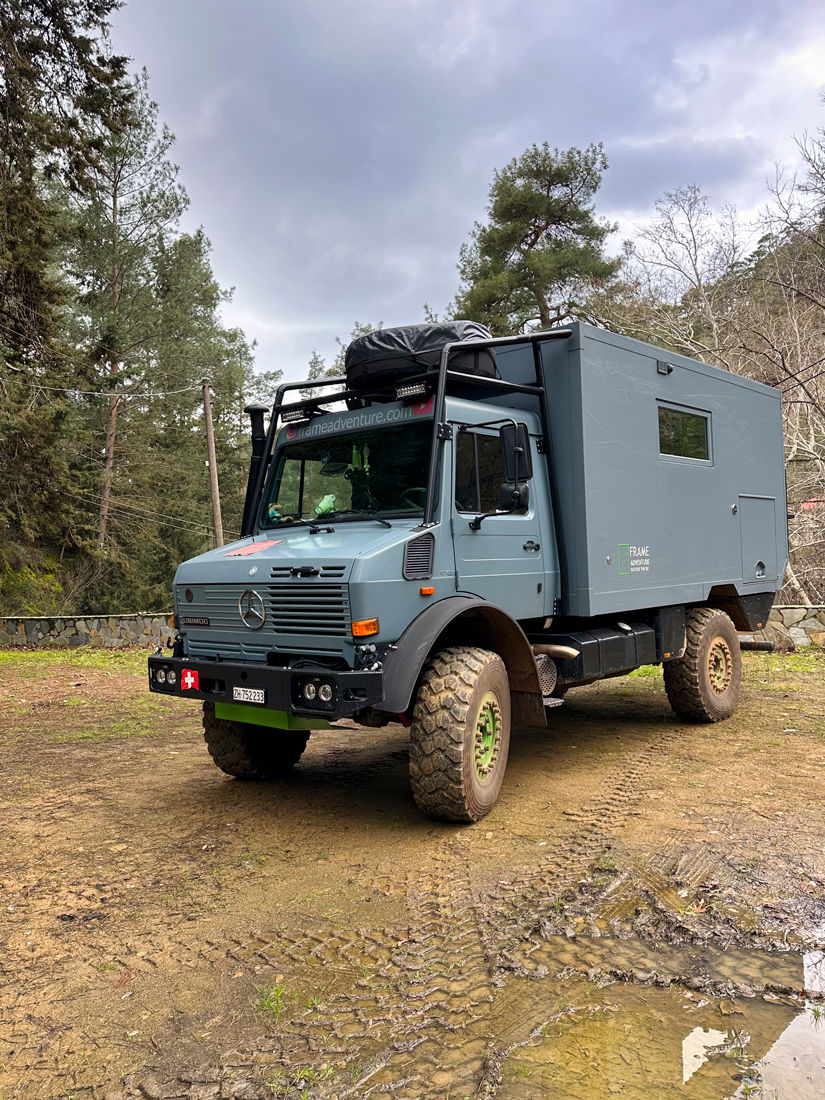
Our new route will take us from west to east across the Troodos Mountains. We start in the forests of Paphos, where the national animal of the Cypriots, the wild sheep, better known as mouflon, is at home. While the driver's eyes are glued to the numerous bends, the co-pilot soon spots the first animal in the wild. In the meantime, we are 800 metres above sea level and can see between the steeply sloping forest sections all the way to the Blue Lagoon, where we were inspired by nature in a completely different environment last week. We park in Stavros. Everything seems to be closed here at the moment. Apart from a campsite, a restaurant with a large picnic area and a fire station, there doesn't seem to be much around here in Stavros anyway. Wait, I was about to forget the most important thing, the Mouflon Enclosure. A tiny little enclosure with far too many of these curly mountain sheep in a very small space. The little stinkers are very curious, just like us. We stare at each other. We are probably a welcome change for the mouflons in the less frequented winter time and we get to know the ancestors of our breeding sheep. Apart from Cyprus, they are also found in the Caucasus region. Judging by their incredible climbing ability, they are more comparable to chamois or, of course, a Unimog!
Above: In close contact with the primeval sheep: the mouflon
below: Green and gnarled: Paphos Forest in the west of the Troodos Mountains
After the Paphos forests, we head further west to the highest peak, the Mount Olympos. While we enjoy the drive on the totally empty mountain roads, we immerse ourselves in the history of the formation of this striking peak. Wherever we look, we see coral-like rock with countless inclusions of tiny shells, but also ores in all colours and lava. The formation of these mountains goes hand in hand with the formation of Cyprus. If the history books are to be believed, 90 million years ago our subsoil rose from 8000 metres below sea level as a result of the Eurasian and African plate collision. This ophiolitic complex (ophis = snake, lithos = stone) is said to have contributed significantly to our understanding of the formation of our earth. We are therefore not only travelling on a geological masterpiece, but also on a rarity in the history of geological formation. The network of well-maintained, albeit narrow and steep roads is also remarkable. Time and again there are turn-offs to small mountain villages or shortcuts to the next little town by the sea. We often drive for kilometres along the mountain ridges with incredible views on both sides, north and south. We are simply thrilled!
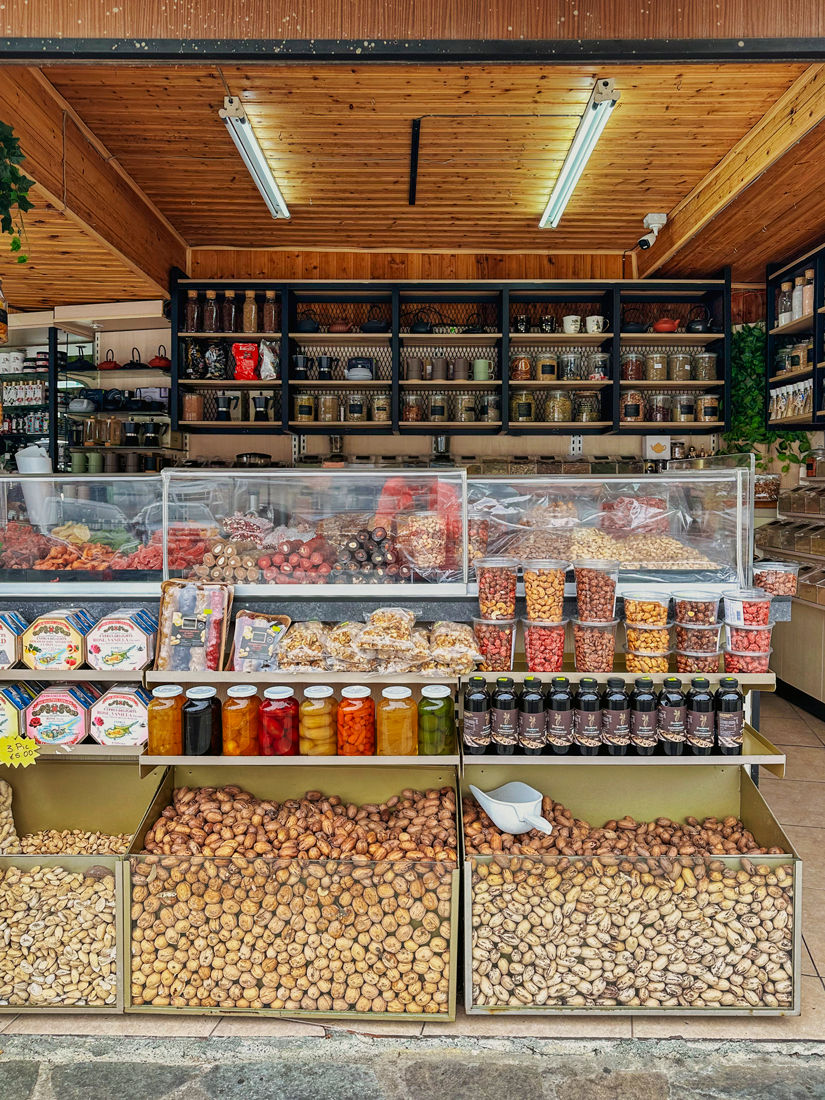
We soon reach one of the many Byzantine monasteries, the Kikkos Monastery. Here, too, there is very little going on and yet the souvenir and snack stalls are almost all open. All kinds of nuts, honey and carob specialities are on offer around the visitors' car park. A paradise for those with a sweet tooth!
Admission to this monastery, like all the others we experience, is free of charge. Of course, the sense and nonsense of charging for historical sights is debatable. However, we would have been prepared to pay a few euros for this very impressive Kikkos Monastery. Instead of the church, a few of the numerous delicatessen vendors now get our cash. To be honest, this is much more gratifying than the anonymous church potty.


The journey on towards Olympos is exciting and fascinating in equal measure. Once again, we are glad that we are here in the low season and the traffic is therefore extremely pleasant. This makes manoeuvring on the steep roads so much easier.
A short detour takes us to Agios Nicolaos, where we want to admire the Greek Orthodox church of the same name "with the roof" (tis Stegis), a UNESCO World Heritage Site. Churches usually stand on a prominent, clearly visible spot. This little church, however, is squeezed into a narrow valley. The cross-domed structure was once part of a monastery complex and gained its significance thanks to its unique wooden gabled roof, which was designed to better protect it from the rainy climate. Whether it was worth the diversion, we will leave open here.

above: typical panorama in the Troodos Mountains with a view of a mountain village
below: The Greek Orthodox church of Agios Nicolaos tis Stegis, the church with the (saddle) roof


As we arrive at the Troodos botanical gardens, the weather deteriorates rapidly. Almost exactly as in the high Alps, the sun is still shining and five minutes later we are sitting in heavy fog. Rain and snow are not long in coming. FRAME snorts past the tourist village of Troodos up to the British Royal Air Force base that has set up on the summit of Mount Olympos. Barbed wire and armed soldiers make us realise that we must finally turn round here. Although somewhat reluctantly, we admit defeat for once. A few hundred metres further down, however, we stand with two wheels on the snow and the other two in the mud so that we can stay more or less straight for the night. We are only a few hundred metres away from the Artemis Trail, on which we want to circle Mount Olympos the next day.
The night is bitterly cold, probably around minus five degrees Celsius, so that in the morning we find shimmering ice like a sugar glaze over our FRAME. We feel like two young dogs who can hardly wait to get going. Fortunately, the weather is better again, even if there are heavy dark clouds on all sides. However, really bad weather is not forecast until the afternoon. The earlier we set off on the seven-kilometre Artemis Trail, the better the chances of getting back dry and avoiding getting caught in the fog.
above: Ice flowers on the roof at sunrise
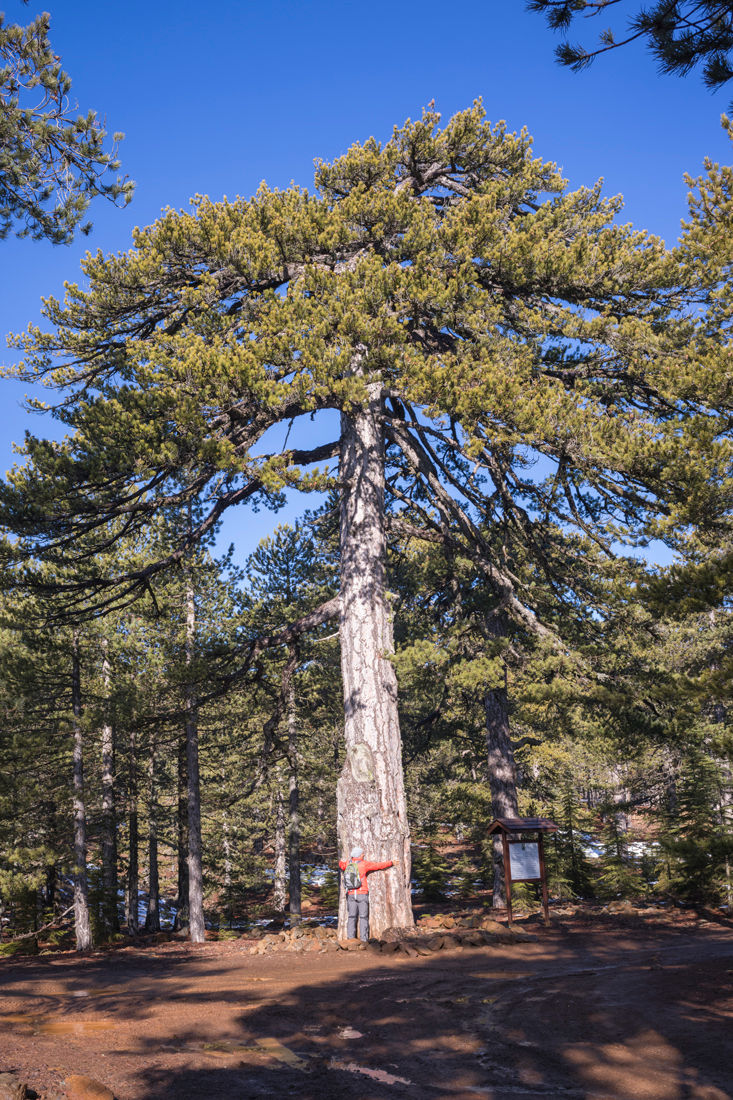
What comes next produces the highest feelings of happiness in us. We hike between centuries-old pine trees on a still frozen nature trail. Again and again we see plants and flowers that we know and ever so often we discover new ones. After every kilometre there is a "milestone" which gives us the certainty that a) we are making progress and b) that we are still on the right path. This is not always easy to ascertain. However, the large parabolic sphere perched like an oversized snowball on the mountain peak that we are currently circling gives us additional certainty that we have not yet lost our way. God knows what technology is hidden under this ball and the high masts next to it. Apparently, the British are spying on communications in the Middle East and can also see meteorites with a diameter of just two metres hurtling through outer space.
We started in the south-east, walk clockwise and gradually reach the north-west after two hours. From here we can see both the coast of Greek Southern Cyprus and that of Turkish Northern Cyprus. The island is literally at our feet. But then wafts of mist rise rapidly along the mountain ridge in our direction. A view restricted by the fog doesn't seem to come in handy on these slippery paths. We force the pace and make sure that we complete the last two kilometres, past ski lifts and toboggan runs, with fewer photo stops. Despite this sudden change in the weather, the Artemis Trail becomes a highlight of our Cyprus discovery.

We continue eastwards. The path now leads us along the southern part of the mountain range, at slightly lower altitudes, as far as Pelentri. Vines alternate with olive and orange trees. From Pelentri, we once again re-enter the heart of the Troodos Mountains. Today we drive to the Kato Milo reservoir just outside Agros. Here we set up camp for the weekend in the immediate vicinity of a spacious picnic area on the lakeshore. Fire pits, drinking fountains, toilet blocks, a playground, everything you could wish for. A few locals are already well into their weekend celebrations. Our resident baker (Brigitte) is once again baking fresh bread, while the navigator is busy planning the future routes. Since we arrived in the mountains, it has been mostly sunny in the morning and rainy clouds have been gathering in the afternoon, as is the case today. Nevertheless, we enjoy the weekend in this beautiful place and even the morning shots of the bird hunters no longer bother us.
It's Monday and Agros is on our to-do list. We reach the small mountain town in just a few minutes from our weekend car park. Our interest is focussed on the Agros rose factory. We've never seen anything like it. Tens of thousands of Damascus roses are actually grown here and then marketed in numerous products. In February, of course, it is not yet the flowering season and yet a lovely rose scent spreads throughout the whole area. The valley is also cosy and warm at this time of year and we can well imagine a flood of pink roses enveloping the surrounding area in a sweet fragrance in May. Not only essences, scented candles, soaps and all kinds of cosmetics are on sale here, but also wine, schnapps, tea, jam and even chocolate! We pick up a few souvenirs for the people back home, fill our lungs with a deep breath of this wonderful rose fragrance and leave again. Agros, or rather this mountain region, is also known for its dried meat products. But the chef waves me off, our fridge is still too full, so I turn the ignition key with a murmur and roar off.
We are not yet out of the village when we are startled by a height limit sign of 2.70 metres. With our actual height of 3.45 metres, we've already successfully passed under a 3.43 metre subway in Scotland. Our FRAME can duck a few centimetres when it counts. But at almost one metre, the situation looks a little more precarious. A totally blind, steeply ascending right-hand bend in these narrow streets warns us to take extra care. Without further ado, we park our truck at the side of the road and ask a group of men what's coming up ahead. In the worst case scenario, we would have to drive quite a long way back. They call a young Cypriot who also speaks our language. Despite his good English, he doesn't immediately understand what I mean. Of course, if you live in the village, you don't pay attention to such signs, especially if they don't concern you personally. Then comes the clarification: at best, there are balconies that protrude into the street. Just stay in the centre and there won't be any problems, not even for our big guy, FRAME. Of course, we don't need oncoming traffic right now. We make our way through the alleyway and pass the protruding balconies and bay windows, which indeed seem to have been badly damaged.
The icing on the cake of our Troodos crossing today is the holy monastery of the Panayia of Machairas. The journey to this hidden monastery is once again winding and lined with spectacular views of the valleys and even the sea in places. Machairas actually comes from the word "machete", which in turn is at the centre of an exciting jungle legend about an icon of the Virgin Mary. Fortunately, we no longer need a machete today, but can reach the monastery gate effortlessly on tarmac roads. We have just arrived at a church service, which is being held with lots of ringing and incense by a dozen or so bearded monks dressed in black robes. Of course, there's no chance of filming or taking photos here, so all we have left are our memories and a few impressions of this impressive site from the outside.
Finally, we visit an organic olive farm at the foot of the mountains. While tasting the fruit and oils, we learn a few new things. For example, that black olives are not a variety, but simply olives picked at a later date. The importance of storage and the age of the trees are a quality feature of the products, almost like with wine. We create space in our food storage cellar and make provisions for worse times.
Above: Certified to be at least 800 years old, an olive tree from Terra Oliva
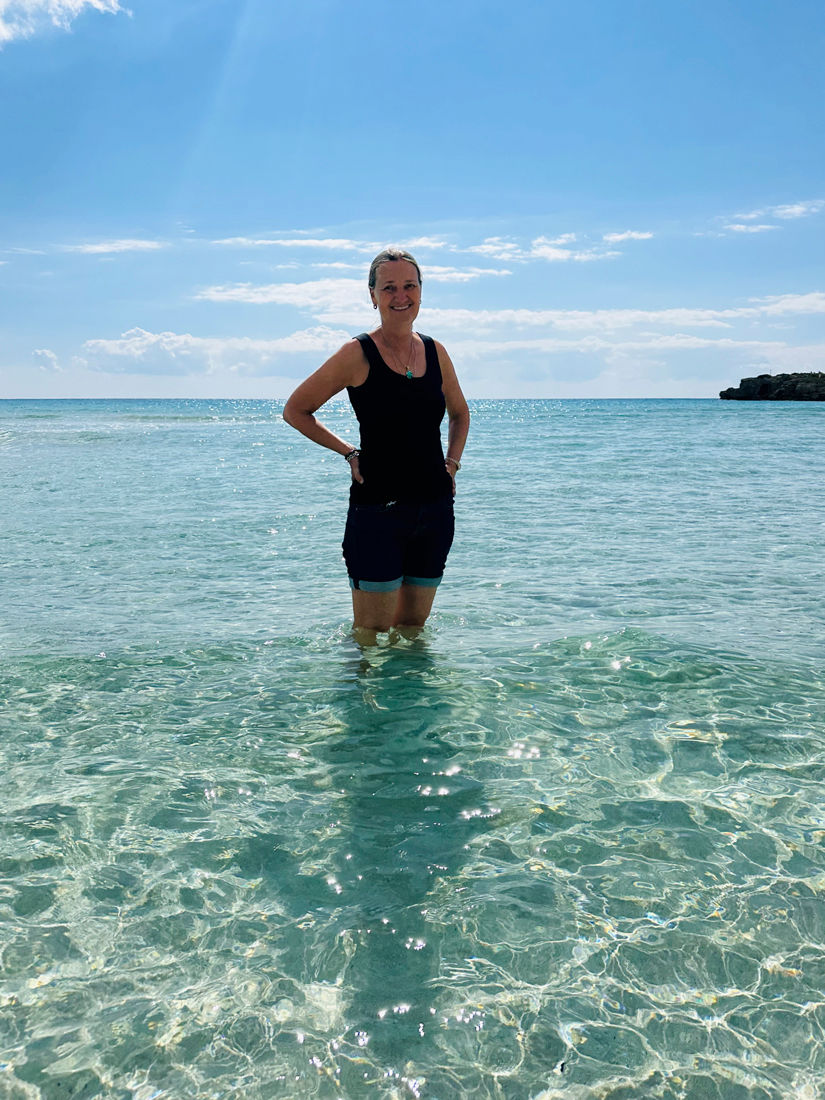
We are torn as to whether we should stay another night in the Troodos Mountains or return to the sea today. In the end, we decide in favour of the sea, not least because we finally want to feel a bit warmer again. The very next day we reach the east of Cyprus and drive through the sophisticated beach resort of Ayia Napa with great excitement. Brigitte has been to these dream beaches before and still remembers the small fishing village very well. Well, that was a while ago and it goes without saying that nothing is the same today. The village has grown into a town several kilometres long with hotels, restaurants, bars and nightclubs. We spend the night at the new Ayia Napa Marina and have the impression that we are in Dubai. Luxury yachts are lined up next to ultra-modern flat blocks and fine gourmet temples. At the moment, however, everything is still running on the back burner. Despite the fantastic weather and comfortable temperatures, it's still low season.
above: A welcoming pitch next to the Ayia Napa Marina
below: Luxury almost like in Dubai
bottom right: Nissi Beach
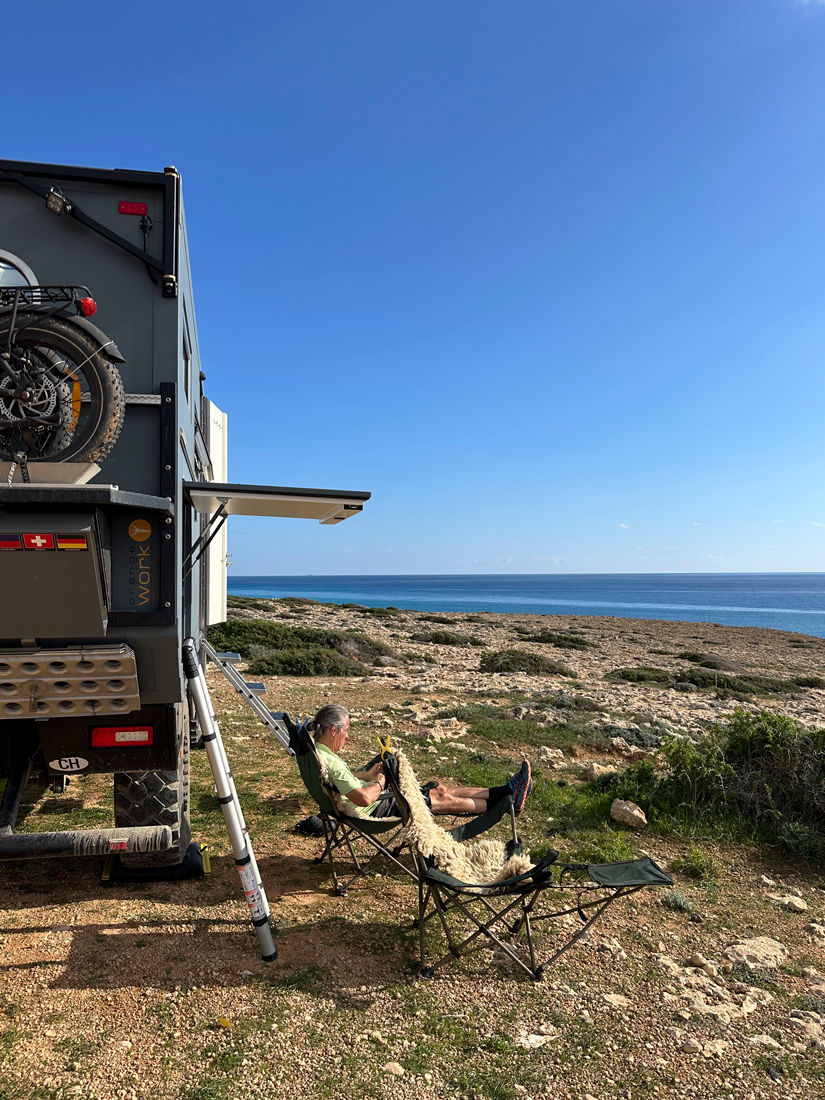
To round off the Greek part of Cyprus, we drive to the south-easternmost corner of Europe, to Cape Greco. At the Ayia Napa Sea Caves, a little away from the sights, there is an opportunity to park with a view of the turquoise blue sea. Above the caves, we meet a group of high-spirited Armenians who dare to plunge ten metres from the cliffs. Cliff jumping is expressly forbidden here, but so is hunting and yet everyone does it.
From here, it takes just over an hour to walk along the coast among orchids, irises and crocuses. However, part of Cape Greco is once again a restricted zone. Where Radio Monte Carlo used to broadcast to the Middle East, the British are now back in control with their radio and radar equipment.

above: Cliff jumping into the turquoise water at the Ayia Napa Sea Caves
below: A nature trail takes us to Cape Greco
Next Blog 4.5: Nicosia & Northern Cyprus a.k.a "Drowned in the swamp"





































































































Comments